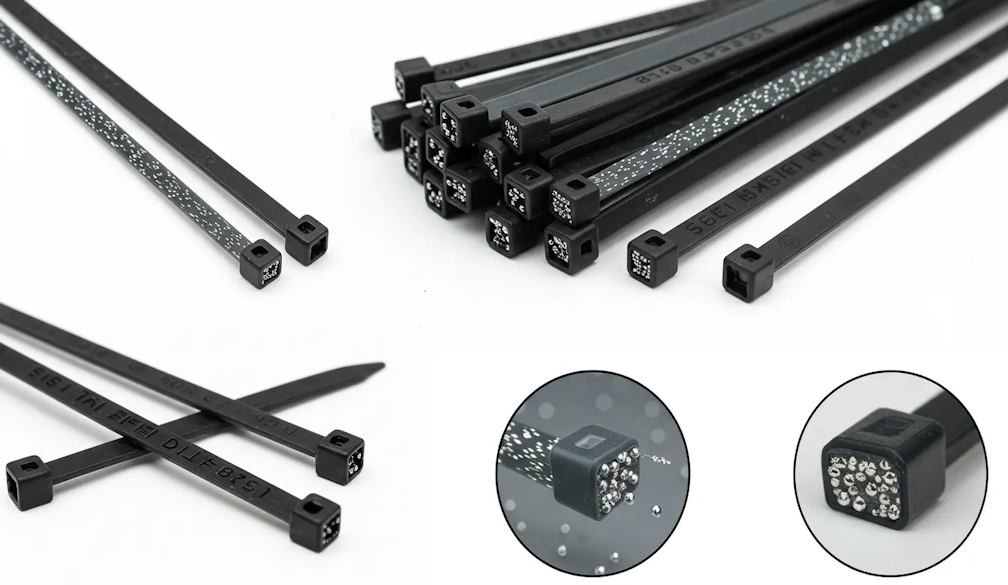Top Applications of Metal Detectable Zip Ties in Industrial Settings

Zip ties are crucial equipment used in many different industries to fasten cables, wires, and other objects and guarantee efficient operation. Metal detectable zip ties have gained popularity due to their unique capabilities, while traditional zip ties are a standard solution. Because these specialty zip ties contain metals that can be detected, they are important safety and productivity tools, particularly in the manufacturing, food processing, and pharmaceutical industries.
Where Zip Ties Can Be Used?
Metal detectable zip ties serve various roles in industrial settings, including:
1. Food and Beverage Industry
The most common application for metal detectable zip ties are in the food processing sector. Using metal detectable ties guarantees that any loose equipment or tie remnants can be quickly found using metal detectors, preventing contamination in settings where contamination risks could jeopardize product safety.
2. Pharmaceutical Manufacturing
Pharmaceuticals require stringent protocols to avoid contamination, similar to food safety. During the labeling, packaging, and manufacturing processes, metal detectable zip ties contribute to safety and cleanliness.
3. Electronics Manufacturing
These zip ties are crucial in securing cables, wires, and components within electronics. Their additional metal detection feature increases operational effectiveness by ensuring they are never missed during quality control inspections.
4. Automotive Industry
Metal detectable zip ties are used in automotive assembly lines to hold other parts together and route cables. Their detectable qualities guard against hidden mistakes that could jeopardize the product or cause production delays.
Benefits of Metal Detectable Zip Ties
1. Enhanced Safety
The main benefit is the improved safety that metal detectable zip ties offer to the food, beverage, and pharmaceutical industries. In such situations, even a small amount of foreign material can cause expensive downtime, product recalls, or serious health risks. Metal makes it possible to recognize and remove these ties with ease.
2. Regulatory Compliance
The use of detectable materials is required by stringent regulations in many industries, particularly in the food processing and pharmaceutical sectors. By incorporating metal detectable zip ties, companies guarantee adherence to safety regulations, including FDA (Food and Drug Administration) and HACCP (Hazard Analysis and Critical Control Point) guidelines, preventing penalties and preserving product quality.
3. Cost Efficiency
Metal detectable zip ties may be a little more expensive than their conventional counterparts, but they save a lot of money because they improve safety and stop recalls. Businesses can avoid fines, product recalls, and reputational harm worth hundreds of thousands of dollars by preventing even one contamination issue.
4. Durability
Due to their sturdy construction, metal detectable zip ties are dependable and long-lasting in demanding industrial settings. These zip ties offer enduring performance regardless of exposure to harsh environments, chemicals, or physical strain.
Things to Consider Before Using Metal Detectable Zip Ties
1. Material Compatibility
Examining the material requirements for your particular application is crucial. Metal additives are often embedded in nylon or other sturdy plastics to create metal detectable zip ties. Ensure that these materials will work with your machinery, equipment, and environment.
2. Detection Equipment
Even though these ties can be found, having the appropriate detection tools is crucial. To avoid them being overlooked, metal detectors in your facility should be calibrated to detect the metal components of these zip ties.
3. Size and Strength Requirements
There are various sizes and tensile strengths of metal detectable zip ties. For reliable performance, choosing zip ties that can sustain the weight and strain of your specific application is essential.
4. Cost Consideration
While the added detection feature enhances safety, it also raises the cost. Determine if the advantages—such as a lower chance of contamination and adherence to rules—outweigh the initial outlay.
Importance of Metal Detectable Zip Ties
In environments where contamination could cause severe consequences, the importance of metal detectable zip ties cannot be overstated. Common metal detection equipment detects misplaced or overlooked zip ties, which reduces the possibility of contamination. These zip ties offer peace of mind and reliability In industries that require strict adherence to health and safety standards.
Furthermore, these zip ties significantly improve workplace safety by avoiding unnecessary shutdowns due to undetected contamination, maintaining a smooth workflow, and ensuring the safety of workers and customers
The use of metal detectable zip ties in industrial settings is more than a precaution; it is an essential tool for ensuring safety, compliance, and efficiency. These zip ties offer a unique combination of utility and protection, whether in food production, pharmaceuticals, electronics, or other sectors. Businesses that incorporate these specialized ties into their operations can not only comply with industry regulations but also protect their reputation and reduce the costs associated with contamination or product recall.









